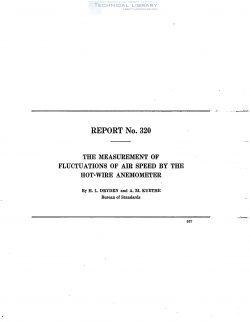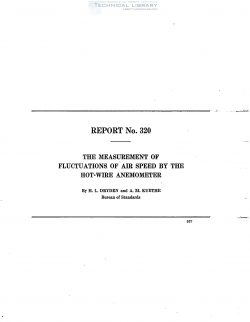naca-report-320

- Version
- 167 Downloads
- 1.57 MB File Size
- 1 File Count
- August 25, 2016 Create Date
- August 25, 2016 Last Updated
National Advisory Committee for Aeronautics, Report - The Measurement of Fluctuations of Air Speed by the Hot Wire Anemometer

The hot-wire anemometer suggests itself as a, promising method for measuring the fluctuating
air velocities found in turbulent air flow. The only obstacle is the presence of a lag due to the limited
energy input which makes area a fairly small wire incapable offollouing rapidr fluctuations with
accuracy. This paper gires the theory of the lag and describesan experimental arrangement for
compensating for the lag for frequencies up to 100 or more per second when the amplitude of the
fluctuation is not too great. An experimental test of the accuracy of compensation and some results
obtained with the apparatus in a wind—tunnel air stream are described. While the apparatus is
very bulky in. its present form, it is beliered possible to de-relop a more portable arrangement.
In a. historic paper (reference 1) Osborne Reynolds distinguished experimentally two types
of fluid motion in pipes which are to—day termed laminar and turbulent. In the laminar motion
the fluid particles follow each other in paths parallel to the axis of the pipe and the flow is steady—
i. e., the speed at any point is not a function of the time. In the turbulent motion the fluid is
filled with a mass of eddies, and while on the average the flow is parallel to the en's of the pipe
there is a rapid fluctuation of the velocity at any point about a mean value. A stream of smoke
or colored fluid introduced into a laminar flow retains its identity for a considerable time,
whereas in a turbulent flow the stream is very rapidly difl'used throughout the fluid. In laminar
flow the stresses are transferred from layer to layer of the fluid solely by the action of molecular
diffusion, whereas in turbulent flow there is in addition a molar difl‘usion or the transfer of momen-
tum by extensive groups of molecules. The velocity distribution in laminar flow may be com-
puted from the equations of motion of an incompressible viscous fluid on the assumption that a
steady state of flow exists in which the lines of flow are parallel to the axis of the pipe.
The speed is found to be a parabolic function of the radial distance from the axis of the pipe. In
turbulent flow the speed is found to vary as a power of the distance from the wall of the pipe
over most of the cross section, but it can not as yet be shown how this result may be derived
from the equations of motion nor can a physical meaning be attributed to the exponent of the
power law.
| File | Action |
|---|---|
| naca-report-320 The Measurement of Fluctuations of Air Speed by the Hot Wire Anemometer.pdf | Download |

Comment On This Post